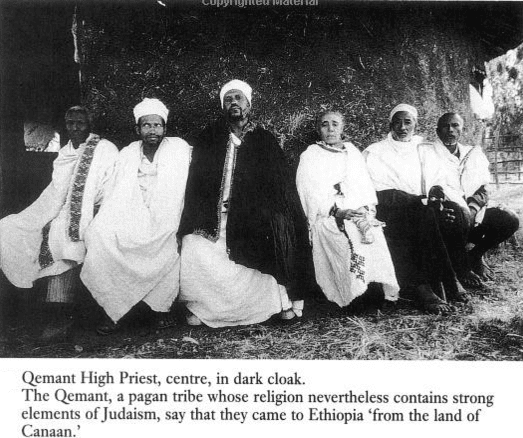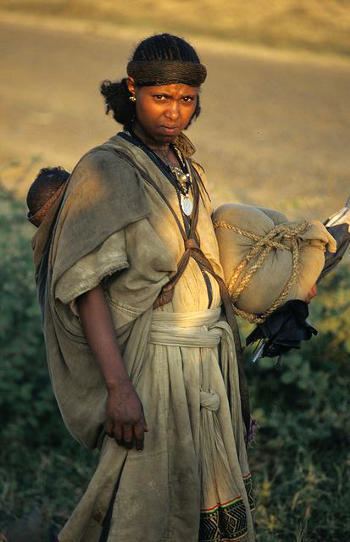 | ||
The Qemant (Ge'ez: ቅማንት?) are a small subgroup of the Agaw people in Ethiopia, who traditionally practiced an early Hebrew religion. Despite their historic relationship, they should not be confused with the Beta Israel.
Contents
The ethnicity's population is roughly 172,000, according to the 1994 national census; the latest available national census, the one performed in 2007, does not list them as a separate group. However, only 1,625 people still speak Qimant, and it is considered endangered, as most children speak Amharic; likewise, adherence to the traditional religion has dropped substantially, as most of the population has converted to Christianity. Converts often consider themselves to have become Amhara.

The Qemant live along an axis stretching from Ayikel in Chilga woreda to Kirakir north to Lake Tana in the woredas of Lay Armachiho, Qwara, Dembiya, Metemma and Wogera; most remaining speakers of the language are near Ayikel, about 40 miles west of Gondar. They are mainly farmers.

The Qemant are divided into two patrilineal moieties, the Keber and the Yetanti; the Keber is higher in rank. A traditional Qemant can only marry a member of the other moiety, so, while the moieties are exogamous, Qemant society as a whole is endogamous.

Religion
The Qemant traditionally practiced a religion which is often described as "Pagan-Hebraic," combining elements from both Judaism and paganism. According to the American scholar Frederic C. Gamst, their "Hebraism is an ancient form and unaffected by Hebraic change of the past two millennia". A recent sociolinguistic survey notes that the Qemant religion is in a very precarious situation since very few people still adhere to it. According to this study, the ratio of those who follow the Qemant religion vs. those who are baptized and converted to Ethiopian Orthodox Christianity is about 1% vs. 99%.
Their religious observances include a literal reading of the 11th chapter of Leviticus (see Kashrut). As with mainstream Judaism, even permitted animals can only be consumed if they are properly slaughtered (see Shechita). Their practices include animal sacrifices, and the tending of sacred groves (called degegna). Worship is conducted outdoors, usually at a site near a sacred tree (called qole), wrapped in variously-colored strips of cloth. This appears to be a survival of a biblical tradition:
Abraham planted a grove in Beersheba, and called there the name of God (Genesis 21:33).and
..where the women wove hangings for the grove (II Kings 23:7).However, due to their dislike to being observed by the increasingly pervasive Christians, they have latterly constructed a prayer-hall at Chelga. The Sabbath is observed on Saturday, when it is forbidden to light a fire. The extent to which other prohibitions, as are found in Judaism, are observed, is unclear.
The Qemant call the Deity Adara (God) or Yeadara (My God) or Mezgana which seems to be his proper name. He is described as omnipresent, omnipotent, omniscient, and anthropomorphic. He is approachable directly or through qedus which are angels or culture heroes.
The highest political and religious leader among the Qemant is their High Priest, called the Wember (also transliterated Womber and Wambar), an Amharic term meaning "seat." There were formerly two superior wambars, at Karkar and at Chelga, with the first being senior, and a varying number of subordinate wambars in other parts of Qemantland. All wambars are chosen from certain lineages in the Keber moiety. The last wambar of Karkar died in 1955, and since then the only wambar has been Mulunah Marsha, Wambar of Chelga (born 1935). Each wambar chose (from the Keber moiety) one or more delegates with the title of afaliq to represent him in judicial matters. These men traveled the countryside, settling disputes, seeing that the laws were obeyed, and punishing wrongdoing, usually with a fine. Each wambar also chose two stewards with different titles, one from each moiety, who served different elements of the sacred meals.
There are two orders of priesthood, the kamazana, the higher, of the Keber moiety, and the abayegariya, the lower, of the Yetanti moiety. Each Qemant locality has at least one of each; they must work together to conduct the traditional sacrifices and other religious ceremonies. When offering a sacrifice, the abayegaria holds the legs of the victim and the kamazana wields the knife. The priests also have a subordinate judicial function.
The Qemant don't consider themselves as Jews.
History
The origins of the Qemant are unknown due to lack of a written history. According to oral tradition, the founder of the Qemant was a man called Anayer, who is said to have been a grandson of Canaan, son of Ham, son of Noah. After seven years of famine in his own country, he is said to have come to the area of Lake Tana, in Ethiopia. As he traveled with his wife and children, he met the founder of the Beta Israel, who tradition states were traveling in the same direction.
According to Wember Muluna Marsha, they were from the same country (which they called Canaan).
As Anayer traveled on the journey with his wife and children, he met the founder of the Beta Israel, also traveling on the same journey with his wife and children. A marriage alliance was discussed between the two groups, but it did not succeed.
According to the early 19th century missionary Samuel Gobat, their Amharic-speaking neighbors considered the Qemant boudas, or sorcerers, along with "the Falashas or Jews (Beta Israel), most Mussulamns (Muslims), and some Christians." Gobat knew little more about this "small Pagan people inhabiting the mountains in the vicinity of Gondar."
According to traditional Amharic-speaking historians, the Qemant were descended from Canaan through his son Arwadi ('the Arvadite') and grandson Anayer. Anayer and his wife Entela are said to have crossed from Asia into Ethiopia in 2101 BC, as one of three Canaanite groups to immigrate when Ethiopia was ruled by Cushites — the other two groups being the Shanqella (Nilo-Saharans) descended from Sini ('the Sinite'), and the Weyto descended from Samri (the 'Zemarite').
